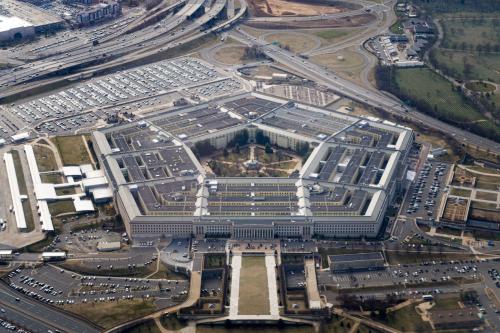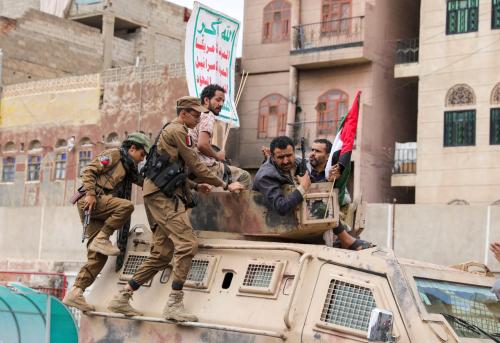Pakistan is at a critical juncture today. The edifice of its long-standing foreign policies in the region stands shaken and an alternative structure is not yet in place. Pakistan’s President and army chief General Pervez Musharaf, in response to America’s clarion call for “either you are with us or against us” in the new war against terrorism, announced a complete turnaround in its Afghanistan policy, making it “the frontline ally” of the US. This article explores some of these swift and dramatic reversals in Pakistan’s foreign policy; the changes it has triggered in the internal dynamics of the country’s politics; and how that might, in turn, impact upon Pakistan’s foreign policy options in the future.
In the aftermath of the terrorists attacks on September 11, Pakistan’s ruling regime decided to turn its back on the Taliban regime in Afghanistan, abruptly and dramatically changing course of its Afghan policy of at least twenty-years standing. Throughout 1980s, Pakistan had played a critical role, along with the US, in forcing the Soviets to withdraw from Afghanistan in 1988. Since then, a fundamental assumption shaping Pakistan’s Afghan policy has been that “a pro-Pakistan or a ‘friendly’ regime in Kabul is imperative to secure Pakistan’s national interests.” On ground, this had translated into picking Pashtun “favorites”—a country that has a 45 percent share in Afghan population and close ethnic ties with Pashtuns in Pakistan—rather than forging a broad-based political regime in Kabul. Pakistan has, since 1988, tried to cobble together at least four governments—all but one ‘Pashtun’—and failed. This strategy was, however, rarely questioned. As Najam Sethi points out, “Pakistan’s obsession with a strong Pashtun state flies in the face of history.”[1] Until 1973 when Afghanistan’s King Zahir Shah, a Pashtun, ruled Kabul, the Afghan government was pro-Soviet and friendly to India. But because it was politically broad-based and decentralized, it posed no security threat to Pakistan which was pro-US. On the other hand, strong and centralized Pashtun governments of communist Presidents Nur Mohammad Taraki and Hazibullah Amin, both die-hard Pashtuns, pandered to Pashtun nationalism in Afghanistan by supporting Pashtun separatism in Pakistan. But in shaping the post-Soviet Afghanistan, Pakistan persisted with its old strategy. Therefore, once the Taliban movement rose in 1994 and captured Kabul in 1996, Pakistan’s ruling regime, once again, abandoned its attempts of bringing about a multi-ethnic government in favour of an avowedly Pashtun regime.
Since then, successive regimes in Islamabad including those led by Benazir Bhutto, Nawaz Sharif and General Musharaf have been practically underwriting the Taliban regime by bankrolling its military operations, providing diplomatic support as the Taliban’s virtual emissaries abroad, arranging training and arms for Taliban fighters, recruiting skilled and unskilled manpower to serve in Taliban armies, planning and directing offensives, providing and facilitating shipments of ammunition and fuel on several occasions, apparantly directly providing combat support. The Taliban regime, however, soon became a liability than an asset for Pakistan’s security interests. It sought to export Pashtun-Islamic fundamentalism to Pakistan’s border provinces in NWFP and Balochistan, become a drag on its resources and a spreading blot on its name in the international arena. At the same time, by playing favoritism, Pakistan ended up alienating Afghanistan’s ethnic minorities such as the Tajiks, Uzbeks and Hazaras, which dominate the Northern Alliance and drove their leadership into the lap of India, Iran or Russia. Currently, Pakistan is caught in an imbroglio where it has abandoned its protégé, the Taliban, but has no friends in the Northern Alliance and, all its attempts to forge an alternative multi-ethnic coalition led by Pashtun leadership with or without King Zahir Shah remains a non-starter. Pakistan’s king-making efforts in Afghanistan over last twenty years has come to haunt it. But the ruling establishment continues to chant the mantra of calling for a “friendly regime” in Kabul which explains its unease and opposition to the US plans of militarily backing the Northern Alliance, allowing them to march into Kabul.
Another critical factor that influenced Pakistan’s disposition towards post-Soviet Afghanistan was a concept of “strategic depth.” The underlying assumption was that if there is a pro-Pakistan government in Kabul, the Afghan territory coupled with Pakistani territory will offer territorial depth to Pakistan while coping with India’s military threats. Not many in Pakistan’s ruling establishment were willing to concede that the changed strategic realities of a nuclearized South Asia and deployment of ballistic missiles had eroded the relevance of territorial depth. But under the pressure of current events, old certainty about these central governing concepts of Afghan depth and strategic space provided by nuclear weapons has all but disappeared.
Pakistan’s relationship with USA, its other critical partner in the Afghanistan project, has also undergone a roller coaster ride from being a “frontline ally” in the 1980s, to a neglected and somewhat recalcitrant country that invited US sanctions by mid-1990s, to once again becoming the “frontline ally,” in the new century. The first time Pakistan fought America’s war in Afghanistan, it had paid a heavy price. While the US walked away after the Soviet withdrawal, Pakistan was left alone battling the aftermath of guns, violence, drugs and a sea of refugees. Some other long-term off-shoots were the growth in sectarianism, the militarization of religion, the spawning of a maulvi and jehadi culture and the spread of madarasa education with all its concomitant consequences for civilian disorder that plagues Pakistan till now. Ayaz Amir put it aptly: “All the glory [was] America’s and all the recurring costs [were] Pakistan’s.” Despite this bitter experience of having been repeatedly used and repeatedly abandoned, Pakistan is, once again, going down that path again arousing fears that the history might be repeated again. This was voiced by none other than General Musharaf, who in an interview to CNN on October 22, said “after the Soviets were defeated in Afghanistan, we were left in lurch.” He then talked about a sense of betrayal and abandonment that most Pakistanis feel. “One of the prime topics discussed all around Pakistan,” he said, is “are we going to be abandoned again?”
This is important to understand. The US-Pakistan differences in the 1990s had arisen not only due to the changed strategic realities of the post-Cold War era when US interest in Afghanistan had dissipated but because their national interests diverged sharply on the nuclear issue. US wanted Pakistan to halt its nuclear programme. Pakistan believed that a nuclear counterweight was the only way to thwart a perceived military threat from a more powerful India. When Pakistan crossed the line of producing weapons grade material in 1990, President George HW Bush imposed sanctions. In the present context too, the convergence of US-Pakistan interests is born out of the current exigencies of the situation and not due to any fundamental shifts in the structural imperatives governing this relationship. However, before we discuss the future scenarios, let us first understand how these sudden and swift changes in Pakistan’s foreign policy arena have influenced the internal dynamics of its politics.
First and foremost, it pertains to the growing “disconnect” between the people and the government. While the Musharaf regime has offered unstinted support to the US including the use of its air bases for its military operations, the anger against the air strikes and Islamabad’s support to Washington, has singed all the four provinces of the country. Pakistan is simmering and the ranks of anti-US demonstrations continue to swell. At the popular level, this may not be for any ingrained support for the Taliban but because of the emotional sympathy for the plight of fellow Muslims although some religious leaders have issued fatwas asking their followers to wage jihad against the US. Nearly ten thousand tribesmen are reported to have gathered in the Bajaur Agency, located around 145 kms from Peshawar, to enlist their services for jihad. Officially, no Pakistani is allowed to cross the border. But the border crossing on top of the hill, Ghaki, has seen thousands cross into Afghanistan.[2] The response to Mullah Sufi Mohammad, the leader of the Tehrik-e-Nifaz-e-Shariat-e-Muhammadi (TNSM) call for help has been massive also in terms of collection of funds for the Taliban war effort: hundreds of kgs of gold, other jewelry, blankets, quilts, warm clothes and even antique guns have landed at TNSM-run seminaries. The divide between the political choices of the government and the society is indeed sharp.
Most political analysts agree that the military regime is not yet facing a crisis and could ride the storm. The army is behind General Musharaf though all is not well. Musharaf had to reshuffle the army command before the air strikes began. All the coup makers and the theocrats who believed in the virtues of jihad were thrown out. These included deputy army chief Lt Gen Muzaffar Hussain Usmani (who resigned after he was superceded), Let Gen Mohammed Aziz Khan and Lt Gen Mohammed Yusuf, both of who were kicked upstairs. They are believed to have developed differences with Musharaf’s strategy of not only trying to present a moderate face of Pakistan to the world but also of about turning the Afghan policy so swiftly. Musharaf decided to purge ISI of the alleged jihadi elements and severe any links between them and the Taliban as also Osama bin Laden. The new members in the Musharaf team are Lt Gen Ehsanul Haq as ISI Chief, Lt Gen Mohammed Yusuf as vice-chief of army staff and Lt Gen Abdul Qadir Baluch as corps commander in Quetta. Ethnicity is a key factor here, a pointer to Musharaf’s political savvy. A mohajir himself, he has brought Gen Ehsanul Haq, a Pashtun, who is also known as a liberal to boot and the Quetta corps commander, as the name itself, implies, would be on home turf. The new team is on the same wavelength as Musharaf, setting the army on a different course.
More significantly, this has ruptured the mullah-military nexus that began with General Zia-ul-Haq’s policies of seeking religious legitimacy for his military coup in 1977. At this juncture, the clerics are on one side, the military commanders on the other. The people of Pakistan, on their own, may never have ruptured it. But for Pakistan to fully recover from the effects of this alliance, this rupture has to be made permanent. The religious parties have always lacked the popular support and they still do. The real challenge lies in rolling back the religious extremism in Pakistan that has become part of the social change in the country since the politics of Shariat began twenty years ago in the Zia era. While the executive drafted draconian laws such as the anti-blasphemy law in dealing with non-Muslims, the judiciary hardened its attitude in deference to the shariat, and the judges took to posturing as more hardline bigots than even the clerics. The presumed stringency of Islamic laws gave birth to a general attitude of intolerance in the society. The organization of jihad in Kashmir stoked this extremism further with the supply of arms and exemption from law for twenty years.
The Taliban phenomenon and the jihad in Kashmir is part of the dynamic of this social change that emanates from the growing dominance of the Deobandi beliefs and practices of Islam in Pakistan. The Deobandis had gone into a decline after 1947 because they sided with the All India National Congress during the Pakistan movement and opposed Jinnah and his Muslim League. When the era of Islamic stringency dawned in Pakistan under General Zia, it was found that barring pockets in the NWFP and Balochistan, most of Pakistan was dominated by the Barelvi clergy. They inclined to “what may be called the Low Chruch, mixing Islam with local mustical influences and ignoring the ancient Islamic schism of Shia and Sunni.”[3] The Afghan jihad brought the Deobandis to the fore. The Barelvis gradually reacted by becoming more stringent and violent. The state remained blind to this change until it was too late. This social change has seeped deep into the body politic of Pakistan and a mere reshuffle of the ISI and army top personnel may not be enough in automatically recasting Islamabad’s foreign policies unless accompanied by rolling back this social change which indeed is a tall order.
Of the holy trinity of Pakistan’s national security, Kashmir, Afghanistan and nuclear weapons, all that still remains intact is the notion of jihad in Kashmir. Will that remain unaffected by current developments remain to be seen because that may well prove to be the ultimate test of General Musharaf’s resolve to “save Pakistan,” as well as Pakistan’s new-found international commitments. If he is serious about joining the war against terrorism, Islamabad could no longer turn a blind eye to the jihadi groups in Kashmir that operate from safe havens and training camps in Pakistan. These jihadi groups have over the years, become the chosen instrument of Pakistani military for imposing a low-cost conflict in Kashmir that continues to bleed India. The Kargil conflict marked the pinnacle of this strategy. Notwithstanding the failure of that venture, the strategy persists. While Pakistan may have cut its ties with Taliban, the military as well as the ISI continue to support jihad. In fact, Musharaf’s public justification for helping the US rested mainly on the need to protect Pakistan’s stakes in Kashmir.
The trouble is that in the post-September 11th-world, the distinction between the terrorists operating out of Afghanistan and jihadis backed by Pakistan in Kashmir, will not be acceptable to the international community. The most clear articulation of this point came from the US President George Bush in his address to the UN Security Council that ”We must unite in opposing all terrorists, not just one of them … Any government that rejects this principle, trying to pick and choose its terrorist friends will know the consequences.” This was not a reference to Iraq, Iran or Libya. This could have been addressed only to Pakistan, or to elements in the Pakistani establishment who resent their country’s support to the US or believe that their reward at the end of the Afghan campaign will be a licence to light the fires again in Kashmir. If Pakistan does not change course on Kashmir, it may yet again, not find US by its side when it matters most. Bush has already hinted, “neither national aspirations, nor remembered wrongs can justify terrorism.” The US administration is well aware of the links between Osama bin Laden’s Al-Queda network and other jihadi groups operating from Pakistan. Groups such as Jaish-Mohammad and Harkat ul Mujahideen have already been banned and the bank accounts of Lashkar-i-Toyaba—all of which operate in Kashmir—have been frozen. More may follow. A global drive against terrorism will sooner or later discover the common architects of the web of terror. This has the potential of forcing yet another parting of ways between the US and Pakistan. US may also not meet Pakistan’s expectations on taking sides on the crucial Kashmir issue against India.
On the home front too, unless the Musharaf regime seriously curbs the jihadi groups, they might become more than a nuisance. It is important to keep in mind that scores of Taliban fighters are not only the products of madrasas in Pakistan but also have families among the Afghan refugees. If the US policy, to which Musharaf government is a party, succeeds in driving Taliban out of Afghanistan, they have only one place to go—Pakistan. They would then, at best, become a source of destabilizing the country and at worst, result in the doomsday scenario of instigating an overthrow of Musharaf’s regime.
An alternative course of action may entail making a ‘virtue of necessity’ in actually curbing the power of the jihadi groups across-the-board and using that as a leverage to persuade New Delhi, with the US help, to seriously find a negotiable solution to the Kashmir issue and to use the US aid of one billion dollars to pull Pakistan out of its deep economic crisis, putting its own house in order. These are difficult choices. Which way will Pakistan go, remains to be seen.



Commentary
Pakistani Choices
January 1, 2002